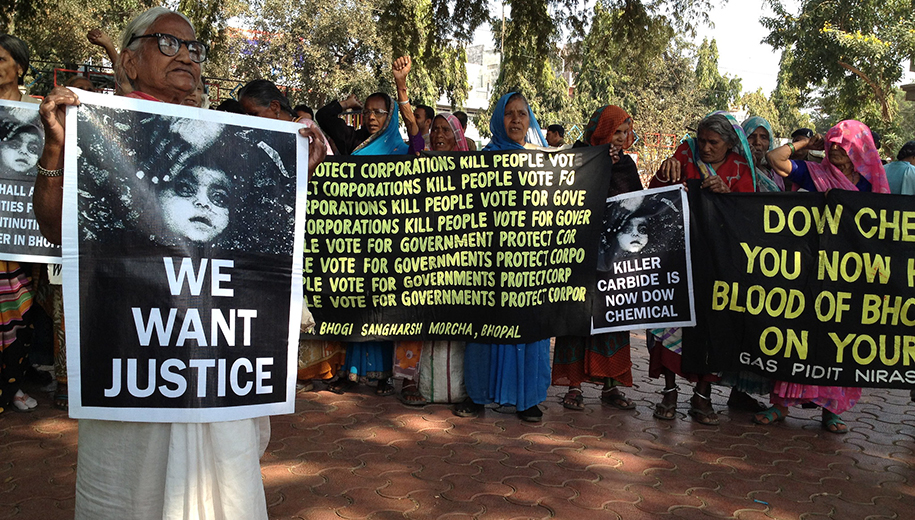18/05/20
Latest gas leak in India — a Bhopal redux

By: Ranjit Devraj
Send to a friend
The details you provide on this page will not be used to send unsolicited email, and will not be sold to a 3rd party. See privacy policy.
[NEW DELHI] What is disconcerting to India’s environment ministry about the 7 May styrene gas-leak tragedy, that killed 13 and over 1,000 hospitalised, is the inconvenient fact that it happened amidst plans to dilute the country’s environment impact assessment (EIA) regime to favour existing and new industrial and infrastructure projects.
On 12 March, the Ministry asked the public to submit comments on proposed amendments to a law that, since 1994, has ensured public participation in the setting up and expansion of potentially polluting industrial and infrastructure projects. A 22 May deadline for the public to comments on the proposed changes was extended to 30 June because of India’s COVID-19 lockdown.
But what became apparent from the horrendous styrene leak from the plant, located in the south-eastern port city of Visakhapatnam and owned by South Korea’s LG was the fact that even the existing EIA laws were being flouted by major industries in collusion with regulators.
“LG officers ought to have taken prescribed precautions before starting the chain of process in the manufacture of polymer by using styrene as an ingredient”
Vijay Panjwani, environment lawyer
So numerous were these violations that in 2017, the Ministry was compelled to announce an amnesty to regularise many projects. But what was condoned against fines is now being sought to be regularised so that projects have better ‘ease of doing business’ and can start without prior environment clearance. The Ministry appears to be ignoring a Supreme Court ruling in April frowning on advance environmental clearance granted to projects.
According to preliminary investigations, the LG plant stored in giant vats at 20 degrees Celsius large quantities of styrene, a colourless chemical needed for making a range of plastics and synthetic rubber. For yet-to-be determined reasons, the temperature controls failed and a safety valve blew off as rising temperatures caused a build-up of pressure allowing large quantities of the chemical to escape into the surrounding inhabited areas and overwhelming the residents.
Investigators say that had the safety valve not blown off, pressure may have built up in the storage tank to a point where a massive explosion could have occurred.
“LG officers ought to have taken prescribed precautions before starting the chain of process in the manufacture of polymer by using styrene as an ingredient. A fitness report of storage tanks and tank seals ought to have been sent to the Andhra Pradesh State Pollution Control Board with a copy to the Central Pollution Control Board which, if not satisfied, has the power to stop the manufacturing process,” says Vijay Panjwani, a leading environment lawyer.
The National Green Tribunal has slapped a punitive fine on LG and declared that, on the face of it, there was "failure to comply with the rules and other statutory provisions… [and that] the statutory authorities responsible for authorising and regulating such activities may also be accountable for their lapses”.
But is that enough? According to Panjwani, the police can register cases of murder for the deaths and for causing grievous hurt to several hundred persons and also arrest LG officers without a court warrant. “The liability of the principal management that is Board of Directors of the principal company is the same as the LG officers managing the Vishakhapatnam factory,” he says.
Nothing of the sort is likely to happen in a country now trying to attract foreign direct investment. Reports say that that arrangements are being made to neutralise the styrene into harmless polymers and ship it to LG’s plants in South Korea for safe storage.
While the two tragedies differ in the scope and scale — Bhopal is said to be the world’s worst industrial disaster — there are striking parallels in the way they visited death and injury on hapless populations, starting with the fact that both are located in the middle of residential areas violating basic safety norms.
It would appear from the Visakhapatnam tragedy that no lesson was ever learned from the Bhopal tragedy in the intervening 36 years. The same disregard for rules and safety regulations and the same systemic collusion between regulatory agencies and corporate entities have continued and are likely to continue under a professedly business-friendly regime.
This piece was produced by SciDev.Net’s Asia & Pacific desk.













